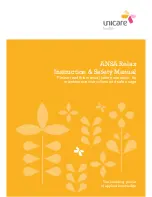
Transporting the Canto Nxt
GB28
The Canto Nxt must be secured in place with
n
anchoring systems suitable to the hook eyes (see
figure 3).
The user must wear a three-point safety belt in the
n
taxibus. These safety belts must be attached to
the taxibus.
The lap belt must be positioned low across the
n
user’s waist (see figure 4). The angle between the
belt and the floor must be between 30° and 75° (a
bigger angle is better).
Pelvic restraints should make full contact
n
across the front of the body near the junction
of the thigh and pelvis. The upper belt must
fully support the user as illustrated in figure 5.
The diagonal belt must be positioned across
n
the user’s shoulder and chest as shown in
figure 6.
The belt must be sufficiently tight but not
n
uncomfortable for the user.
The belt must not be twisted.
n
The belt must not be resting against armchair
n
components (like armrests or wheels) as a
result of which it is no longer fully supporting
the body of the user (see figure 7).
If possible, the Canto Nxt should not be transported
n
in a tilted-back position.
The Canto Nxt must be transported with the
n
user facing forward, with a securing system that
complies with the instructions of the manufacturer
of the securing system.
The three-point safety belt is intended to avoid
n
injury to the head and chest.
If a worktop is fitted, it must be removed in order to
n
prevent injury to other passengers. The worktop should
be safely stowed away elsewhere in the vehicle.
If possible, any accessories must be secured or
n
removed.
Following an accident, the wheelchair must be
n
assessed by a representative of the manufacturer
to ensure that it can still be used.
Figure 4
1
2
55˚
Figure 5
Figure 6
Figure 7
















































